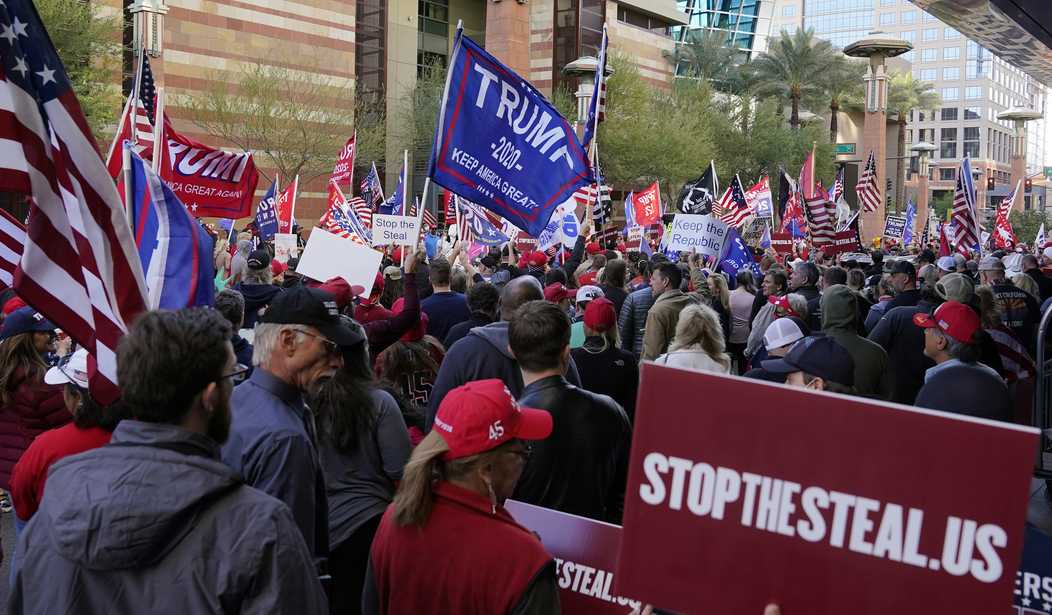On Monday, Arizona Republican state representatives and state senators held a public hearing in Phoenix on problems of voter fraud and irregularities in the state during the election.
“The purpose of this public hearing, an inquiry into the integrity of the election that just passed, is to provide a forum where no others have been permitted for the president’s litigation team to present the evidence and testimony,” said Arizona state Rep. Mark Finchem, who organized the hearing explained.
President Donald Trump called in to the hearing, just as he had during the Pennsylvania hearing.
MUST WATCH: Witness at #ArizonaHearing says the signature on ballots "didn’t even resemble, in any way" what they were matching it to, says they were "completely illegible" and was told not to worry about it pic.twitter.com/TB5T9qvfa7
— Team Trump (@TeamTrump) November 30, 2020
Witnesses, some of whom also had signed sworn affidavits under penalty of perjury about what they were saying, detailed substantial questions throughout the day before nine Republicans lawmakers and the president’s team of attorneys looking into the questions.
Here were just a few of the issues raised.
One poll watcher spoke on how apparently the election officials seemed to have no idea how many ballots were out there. Or more exactly they kept thinking they were done, but then more kept showing up. How do you not know how many are out there?
Witness in #ArizonaHearing: "They thought they were done [counting ballots] and then more truck loads of ballots were coming in. I'm like, 'how can you not know how many ballots are still out there?'" pic.twitter.com/DSt0uo6Qwf
— Team Trump (@TeamTrump) November 30, 2020
They had a cybersecurity expert who detailed how the Dominion machines were capable of being connected to the internet and that evidence did in fact show they had been connected to the internet on Election Day. That raises all kinds of questions about security.
“The Dominion suite user manual is about an inch and a half thick. My team went back through the user manual and looked at all the instances where in the user’s manual, it tells operators to connect the ethernet cords to the router, and it is, the systems are connected to the internet,” said Phil Waldron, a cybersecurity expert and retired Army colonel.
“Our teams looked at spirographs on the Dominion network on Election Day and showed the increased web traffic, internet traffic on Election Day for Dominion servers.
“In a nutshell, these systems are not what you’ve been told, if you’ve been told anything.
“They are connected to the internet. There is no transparency of how the voter information is processed, moved, and stored. And, as a matter of fact, these companies have refused to allow any type of inspection into their code and they always decry, it’s our IP, it’s IP protection.”
That’s a big problem.
Here’s mathematician Bobby Piton saying there were statistical anomalies and he staked his life that there were big problems.
Bobby Piton testifies on the data he has collected county by county showing clear anomalies:
Consistently finds 95-99% of registered voters "voted" in key demographics and counties according to official government data.
"Something is very wrong"@OANN https://t.co/57cfH9kGVS
— Chanel Rion OAN (@ChanelRion) November 30, 2020
There were also questions about the checking of the signatures.
MUST WATCH: Witness at #ArizonaHearing says the signature on ballots "didn’t even resemble, in any way" what they were matching it to, says they were "completely illegible" and was told not to worry about it pic.twitter.com/TB5T9qvfa7
— Team Trump (@TeamTrump) November 30, 2020
Matt Braynard with the Voter Integrity Project focused on people whose ballots were counted, but they had not requested ballots, like Nahshon Garrett who had actually moved to Tennessee to train for the Olympics and did not vote in Arizona. But someone did in his name and the signature was verified. And he wasn’t the only one. That raises the question of who was behind it and how many did that involve, not to mention why the signature was verified when it wasn’t him.
.@MattBraynard referencing the Nashon Garrett clip shown in the previous tweet.
"Who cast Nahshon Garrett's ballot?"
"It was signature verified! Something went wrong here."
"I'd really like to know the answer to that question and I don't think I'm alone." pic.twitter.com/3LTiPCqdyd
— The Columbia Bugle 🇺🇸 (@ColumbiaBugle) November 30, 2020
“A formal legal elections challenge is expected to be filed soon alleging that the process used to validate ballots returned by mail was legally insufficient,” the Arizona Republican Party said in a statement. “The critical process of verifying a signature determines whether a vote is counted.”
Finchem said that they would be calling for a resolution to delay the release of the state’s Electoral votes.
“We are clawing our Electoral College votes back, we will not release them,” Finchem said. “That’s what I’m calling on our colleagues in both the House and Senate to do—exercise our plenary authority under the U.S. Constitution.
“There is a legal brief out there that says we are not tethered to state statute when it comes to this one question.”
According to Finchem, the move would be easy to make and would be legally binding.
“A simple majority can call the House and Senate back, and in a day can pass a resolution and cause those electoral votes to basically be held,” he said. “And it is binding—I’ll see y’all in court.”
The question is whether they have sufficient Republican support to be able to get it done in time.













Join the conversation as a VIP Member